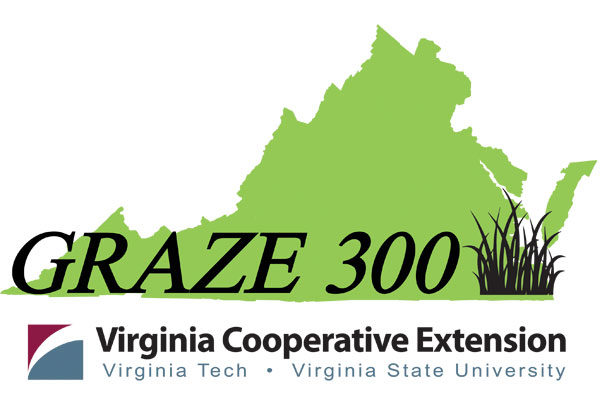“But I’ve had to change my thinking,” he adds.

Boldridge decided to give the Graze 300 VA program a try when profit margins in the cattle industry thinned. Graze 300 VA, a Virginia Cooperative Extension educational program, helps producers realize the potential economic benefit found from a longer grazing season. The longest grazing season in the program’s case studies (year-round) shows a profit but not nearly as high as a grazing season of 300 days – about 50% more profitable by comparison.
Carl Stafford, senior extension agent in Culpeper County, explains the discrepancy. “A number of large-herd examples support this finding, as does work by Dr. Greg Halich in Kentucky (Picking apples off the grazing tree). You would think year-round grazing would be best, but the stocking rate is so low the numbers never add up when compared to 300 days of grazing, which supports a larger herd. And as these animals are profitable and there are more of them, the total net return is higher when hay is fed for about 60 days.”
Hay is the largest cost of any grazing operation. Economists say hay constitutes 50% to 75% of total costs and is the first place to start to improve profitability. During times of high cattle prices, it matters little what you do – but those days are behind us, so as margins shrink it’s a good time to tighten up if you seek more profit from your grazing livestock. Feeding less hay is supported by stocking rates of multiple acres per cow-calf pair, timely rainfall, adequate soil fertility and a willing manager, Stafford says. In Virginia, 3 acres per pair will support grass accumulation for stockpiling. (Your region could be different.)
With this kind of stocking rate, residual forage remains going into the critical fall stockpiling period, and if it rains then in early fall across the Fescue Belt, grass will stockpile even more for the winter grazing days needed to get past January.
“Stockpiled fescue is tremendous feed, especially after frost,” Boldridge says. “After frost, a lot of toxins aren’t getting nearly as high. According to some sources, stockpiled fescue can be greater than 20% protein. And if you manage the grazing well, then you don’t have the cost of cutting, baling and storing the feed.”
The problem comes when producers have to take cattle off fescue in order to let it grow. What then? In order to take advantage of stockpiled fescue, Boldridge doesn’t necessarily save all of his hay to feed in cold months but, instead, may feed hay in late summer or early fall after the warm-season grasses have been utilized. This gives the cool-season grasses, like fescue, time to rebuild in preparation for stockpiled feed.
“New Zealanders speak of a feed wedge – an inventory carried not in the barn but on pasture,” Stafford says. “Allowing the grass to get ahead of you is one way to put it, but instead of a negative, it turns out to be positive when seeking more days of winter grazing. Some worry this feed will not keep or will weather too much to be of sufficient nutritional value. While it’s true some grasses do not stockpile well, you can graze these first.”
Fescue, a favorite of winter graziers in the U.S. Fescue Belt, has a shelf life compared to other grasses and can support winter grazing. “In early winter, it will make a dry cow fat and, in late winter, she will maintain on it. Often, stockpile is the best feed on the farm, even when compared to most hay,” Stafford says.
A short summary of the Graze 300 program is to stock your pastures so grass can accumulate, to have fencing that puts you in control of grazing intervals, to have water access in support of your management, and plan on about 60 days of hay feeding. These things will allow you to carry more animals and accumulate more total net return from your grazing herd, Stafford says.
“You have to change your mindset,” Boldridge says. One concept producers have to accept is that fields won’t look neatly mown. “My dad made a bunch of fields of hay, but when he got older and wanted to retire, the fences were worn down and cow numbers were down. I put up polywire fencing because that was all I could afford and tried to build cow numbers, and I’ve been going 20-some years now,” Boldridge says. “It may not look as nice as when it’s cut with a mower, but if you develop a grazing eye, you can begin to see the beauty of what’s happening. Some people just think it won’t work – and it won’t work for them because they’ve already got their mind made up.”
Boldridge adds, “But it’s not that complicated. And you don’t need 20 paddocks to make things work. You just need to start somewhere and then be observant, watch what happens and figure it out for your operation.”
One thing is for sure, Boldridge notes, it won’t come together perfectly the first year or two, but each year allows a producer to build on what was learned from the previous year, “and then the weather will change, and you’ll have to modify your plan again. Staying flexible is key.”
For more information, visit Graze-![]()
PHOTO: Roy Boldridge has increased the number of his herd’s grazing days through better pasture management, as taught by the Graze 300 program in Virginia. Photo courtesy of Virginia Farm Bureau Federation.

-
Lynn Jaynes
- Editor
- Progressive Forage
- Email Lynn Jaynes








